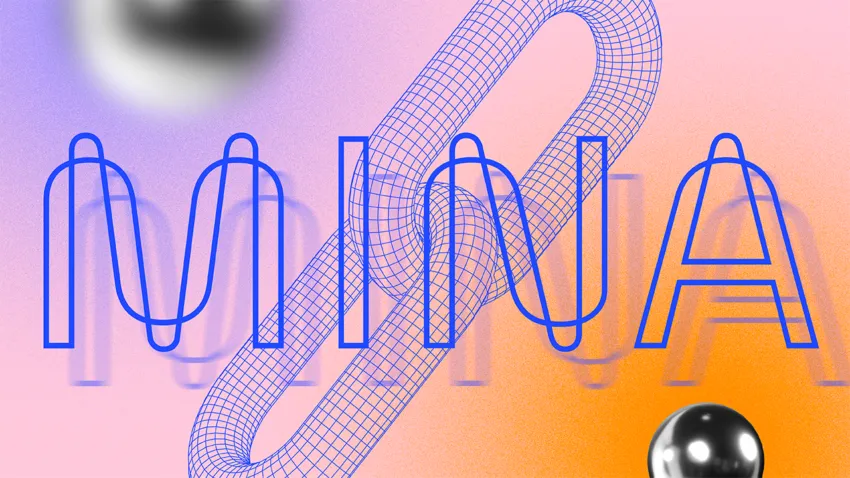The Mina Protocol has big ambitions: solving the blockchain trilemma. This term describes the inherent trade-offs that come with blockchain technology. Blockchains can offer security, scalability, and decentralization, but never all three simultaneously. The blockchain trilemma defines a scenario where only two of these features can be achieved simultaneously. Ethereum, for instance, is secure and decentralized but suffers scalability, while some blockchains like EOS and Ripple sacrifice decentralization for scalability and security.
Typically, a perfect blockchain technology would have airtight security, an extensive decentralized network, and an immense capacity to handle huge volumes of transactions. Mina Protocol, the world’s lightest blockchain and its native MINA crypto, seeks to be the perfect blockchain, balancing scalability, decentralization, and security using Zero-Knowledge Proofs.
BeInCrypto Trading Community in Telegram: read reviews on the best crypto projects, get technical analysis on coins & answers to all your questions from PRO traders & experts!
What is Mina Protocol?

Mina Protocol is a uniquely small blockchain that utilizes zero-knowledge smart contracts (zkApps) to offer a private, secure, and scalable infrastructure for the web3 ecosystem. Unlike several blockchain platforms prioritizing scalability over decentralization, Mina focuses on decentralization to ensure a robust network.
Popular blockchains, such as Bitcoin and Ethereum, accumulate data over time as more blocks are added to them through increasing transactions. These blockchain networks currently have hundreds of gigabytes in storage. The Bitcoin blockchain, for instance, currently sits at 472.9 gigabytes as of April 14, 2023. That’s an increase of over 100 GB since 2021.
However, with the Mina blockchain, the storage size remains fixed at 22KB. This guarantees a seamless process for verifying and achieving the consensus state of the network using a 22KB zero-knowledge proof.
Origin of Mina Protocol
Evan Shapiro and Izaak Meckler brought the Mina Protocol to life in mid-2017. The two cryptography experts wanted to solve the blockchain trilemma. They proposed a solution to one of the key issues with Ethereum: having to trust a third party before running a full node.
The Mina team believes that relying on centralized services like Infura or Alchemy for app development can undermine the trustworthiness of the underlying blockchain. Furthermore, it can result in a suboptimal user interface and developer experience. Instead, the team has chosen to prioritize low storage costs to allow for full nodes to be run by anyone.
In 2020, Mina was launched after undergoing several testnet phases, with the economic whitepaper released in October of the same year. The technical whitepaper followed in March 2021. In October 2020, Mina was rebranded from Coda Protocol after facing a lawsuit with R3’s Corda name trademark. At this time (mid-April 2023), the Mina Foundation’s board of directors includes Evan Shapiro (CEO of Mina Foundation), Josh Cincinnati, and Jill Carlson.
The team remains committed to building and improving payments use-case where previous blockchains have fallen short. The ultimate objective of the Mina network is to develop a decentralized payment framework that effectively verifies system history without depending on any external service. With this, Mina becomes more available to developers via optimized full nodes to run within web apps or smart devices.
Funding
The Mina Protocol team successfully raised $92 million in March 2022, spearheaded by FTX Ventures and Three Arrows Capital. Following the raise, the team stated they would use these funds to expedite the adoption of Mina as the premier zero-knowledge platform within web3, drawing in top-tier developers to the network.
Roadmap
What does the future of the Mina Protocol look like? What are the blockchain’s plans and ambitions? For starters, Mina is looking to appeal to developers, with a key aim being to ramp up Mina’s power. The roadmap is separated into five core areas. The first is Trust Minimization; the aim here is to make the altchain even more invulnerable to attacks and continue to focus on security.
ZK-Programmability focuses on building the best possible ZK programmability layer on Mina. Settlement Layer Performance covers the protocol’s aims to optimize Mina’s latency, finality, and throughput performance layers. The Minaverse section has a strong and exciting focus on interoperability. Meanwhile, the Road to DAOification is focused on setting up a system of decision-making for Mina in order for the blockchain to function effectively and have a positive impact on the world.
How does the Mina Protocol work?
Mina Protocol uses a set of hybrid Zero-Knowledge proofs (zk-SNARKs), a unique node structure, and a technical framework. At the most basic level, Zero-Knowledge proofs are a technology that allows users to prove they have certain information or are a particular person without revealing any of the actual data to the other party. Building on this, the Mina Protocol introduces a mechanism called Recursive Zero-Knowledge Proof.
Utilizing Recursive zk-SNARKs — a unique, succinct blockchain — Mina protocol is able to efficiently verify each transition in real-time, regardless of the number of previous transitions in the system. A new generation of participants powers the lightest blockchain in the world. The platform’s whitepaper also states that it offers a payment system with a fast verification time of 200 ms.
Recursive zk-SNARKs ensure a historical ledger’s constant-time correctness verification. Instead of each participant verifying transactions independently, the network generates proofs-of-correctness for transactions (zk-SNARKs) and shares them around the network. This eliminates the need for users to rely on intermediaries for accurate ledger information. Instead, users receive the ledger state along with a zk-SNARK, which guarantees the state’s accuracy cryptographically.
In essence, the platform aims to create a decentralized payment system that offers efficient verification of the system’s history from the origin without relying on external advice.
Network roles and incentives
Mina uses the Ouroboros Praos Proof-of-Stake (PoS), a mechanism developed by IOHK, one of the companies behind Cardano. It was designed to be simple, enabling all participants to contribute proportionally based on their stake in the protocol. Low bandwidth requirements ensure a high level of inclusivity.
Verifiers
Anyone can become a verifier on the Mina Protocol. Since it constantly uses recursive zk-SNARKs to prove state validity, full-node security is achieved by downloading a zk-SNARK, which is about a hundred bytes and takes a few milliseconds of compute to verify. As a result, verifiers are instrumental in maintaining the network secure and valid.
There are two groups of validators in the Mina blockchain:
Blockchain producers are responsible for selecting which transactions to include in the next block. They tend to prioritize transactions with the highest fees. To add five transactions, a Block Producer must also add five corresponding transaction SNARKs. These can be obtained on the Snarketplace, a special market from other specialized network participants known as Snarkers.
Snarkers or Snark-workers are network members who create zk-SNARKs to verify transactions. They receive a commission for their work, and if their SNARKs are used in a block, the Block Producer pays this fee out of the total transaction fee.
Features of Mina Protocol
- Access global money with Mina: Access peer-to-peer stablecoins and tokens worldwide using a 22 kb^ Mina chain, making global transactions from smartphones and browsers without providing personal data to centralized entities.
- Develop zkAppS3, privacy-enhanced apps: Create decentralized applications (DApps) using zk-SNARKs to preserve data-level privacy, verifying requirements without exposing user information.
- Unlock enterprise interoperability with Mina: Leverage the cost-efficiency and privacy of private chains with the interoperability of public chains using Mina, enabling efficient enterprise interoperability.
- Empower businesses with Mina: Empower small and medium-sized businesses globally to create crypto products, seamlessly integrating them into traditional financial solutions. Third parties will not control the creation, implementation, and operation processes and will not require high costs or specialized technical knowledge.
- Reduce transaction fees and boost trustless transactions: Enable trustless e-commerce and peer-to-peer transactions without the need for centralized intermediaries, thereby minimizing transaction fees and making global transactions seamless.
- Enable secure and fair financial services: Verify relevant information securely and without accessing private user data, ensuring lenders use only fair criteria to make decisions.
- Facilitate private and auditable elections: Guarantee fully verifiable and auditable elections while preserving privacy and protecting voting information.
Perks and pitfalls of the Mina Protocol
One of the major perks of the Mina protocol is its redefining approach to blockchain verification and storage that consistently limits the overall size of the blockchain. The team describes it as the perfect bridge between the real world and crypto.
Higher throughput: Mina protocol facilitates equal participation in the network while also increasing throughput. The nodes have seamless interaction. As such, they attain consensus speedily.
Improved decentralization: Since almost anyone can be a participant, the distribution of nodes ensuring is wider, fostering decentralization without relying on any third party.
Mina’s Snapps – zkApps unique decentralized applications that use cryptography to carry out trustless blockchain transactions:
With these zkApps, users can:
- Explore real-world information.
- Access simple verification and improved accuracy for complex calculations
- Run a full node on a smartphone.
Here are some pitfalls:
- Mina has a speed of just 22 TPS
- Mina protocol cannot handle many transactions simultaneously
- Increase in the number of forks based on technology
Mina coin (MINA)
MINA is the native cryptocurrency that powers Mina Protocol. The native coin interacts with the network and pays for transactions. With MINA, holders can directly stake and earn as well as validate transactions. Users can also use MINA to interact with Snapps — zkApps decentralized applications (DApps) running on the protocol.
As of April 15, 2023, approximately 884 million MINA are in circulation, against a total (uncapped) supply of about 1 billion tokens. MINA has a market cap of $718.1 million, with the price of MINA currently trading at $0.81.
Tokenomics
The initial supply of MINA is 1 billion. The supply is not capped and is expected to increase over time. Each MINA token is divisible up to nine decimal places. Mina protocol aims to reward participants that interact in the ecosystem’s governance and stake their tokens for the long run.
Mina Protocol introduces inflation as a penalty for users holding their tokens without staking. Further decrease in the inflation rate will be subject to Mina Protocol’s governance. In order to encourage stakers, Mina Protocol launched with an annual inflation rate of 12%. It plans to reduce that rate to 7% by 2026. This inflation combines the value of held tokens, providing users a reward to stake and participate in the network’s governance. The rewards often fluctuate in regard to the amount of staked assets on the protocol.
MINA uses
- Trade: Users can buy and sell or swap MINA like any other cryptocurrency
- Stake: Users holding MINA can stake their tokens to earn rewards for securing the network.
- Payment: MINA is the legal tender and the primary payment medium of the MINA Protocol
- Rewards: MINA is used to incentivize block producers to produce new blocks and reward Snarkers, who prove transaction validity.
- MINA also interacts with Snapps (DApps built on the Mina Protocol). For example, users can use the MINA crypto to interact with Teller Finance. This algorithmic credit risk platform uses Mina Protocol technology to create a decentralized lending market. This service offers users easy access to premium on-chain services while securing their personal information.
Distribution
The MINA initial distribution is as follows:
- Community: 40.3%
- Core contributors: 26.3%
- Backers: 20.5%
- Labs endowment: 7.5%
- Mina Foundation: 6%
MINA wallet
Currently, the Mina community has developed two primary wallets — Clorio and Auro. The Mina Foundation has stated there are no current plans to create an official wallet.
Does the Mina Protocol have a bright future ahead?
The Mina blockchain certainly stands out from the crowd and offers an innovative solution to the blockchain trilemma. Its consistent approach to maintaining a constant-size network, facilitating scalability, security, and decentralization is an admirable and enticing concept.
Should Mina Protocol continue to deliver on its multi-year roadmap, the blockchain may become increasingly important, particularly in empowering non-native web3 businesses to adopt blockchain technology and facilitating multi-chain interoperability.
Frequently asked questions
What is the Mina protocol used for?
Is Mina built on Ethereum?
Who is behind the Mina coin?
Who is the CEO of Mina coin?
Disclaimer
In line with the Trust Project guidelines, the educational content on this website is offered in good faith and for general information purposes only. BeInCrypto prioritizes providing high-quality information, taking the time to research and create informative content for readers. While partners may reward the company with commissions for placements in articles, these commissions do not influence the unbiased, honest, and helpful content creation process. Any action taken by the reader based on this information is strictly at their own risk. Please note that our Terms and Conditions, Privacy Policy, and Disclaimers have been updated.




